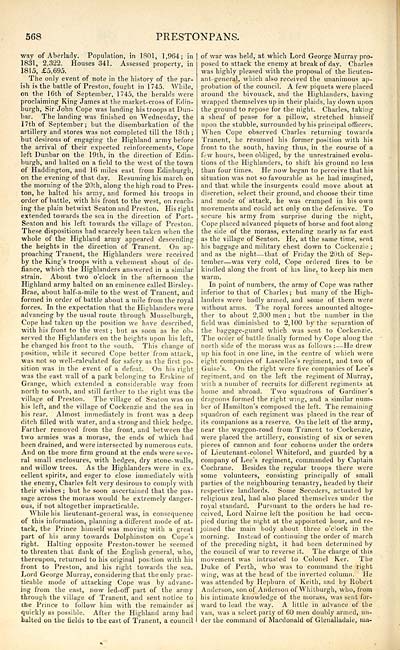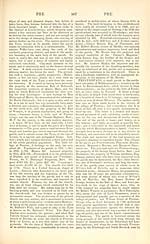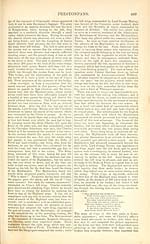Topographical, statistical, and historical gazetteer of Scotland > Volume 2
(584) Page 568 - PRE
Download files
Complete book:
Individual page:
Thumbnail gallery: Grid view | List view

568
PRESTONPANS.
way of Aberlady. Population, in 1801, 1,964; in
1831, 2,322. Houses 341. Assessed property, in
1815, £5,695.
The only event of note in the history of the par-
ish is the battle of Preston, fought in 1745. While,
on the 16th of September, 1745, the heralds were
proclaiming King James at the market-cross of Edin-
burgh, Sir John Cope was landing his troops at Dun-
bar. The landing was finished on Wednesday, the
17th of September; but the disembarkation of the
artillery and stores was not completed till the 18th ;
but desirous of engaging the Highland army before
the arrival of their expected reinforcements, Cope
left Dunbar on the 19th, in the direction of Edin-
burgh, and halted on a field to the west of the town
of Haddington, and 16 miles east from Edinburgh,
on the evening of that day. Resuming his march on
the morning of the 20th, along the high road to Pres-
ton, he halted his army, and formed his troops in
order of battle, with his front to the west, on reach-
ing the plain betwixt Seaton and Preston. His right
extended towards the sea in the direction of Port-
Seaton and his left towards the village of Preston.
These dispositions had scarcely been taken when the
whole of the Highland army appeared descending
the heights in the direction of Tranent. On ap-
proaching Tranent, the Highlanders were received
by the King's troops with a vehement shout of de-
fiance, which the Highlanders answered in a similar
strain. About two o'clock in the afternoon the
Highland army halted on an eminence called Birsley-
Brae, about half-a-mile to the west of Tranent, and
formed in order of battle about a mile from the royal
forces. In the expectation that the Highlanders were
advancing by the usual route through Musselburgh,
Cope had taken up the position we have described,
with his front to the west ; but as soon as he ob-
served the Highlanders on the heights upon his left,
he changed his front to the south. This change of
position, while it secured Cope better from attack,
was not so well-calculated for safety as the first po-
sition was in the event of a defeat. On his right
was the east wall of a park belonging to Erskine of
Grange, which extended a considerable way from
north to south, and still farther to the right was the
village of Preston. The village of Seaton was on
his left, and the village of Cockenzie and the sea in
his rear. Almost immediately in front was a deep
ditch rilled with water, and a strong and thick hedge.
Farther removed from the front, and between the
two armies was a morass, the ends of which had
been drained, and were intersected by numerous cuts.
And on the more firm ground at the ends were seve-
ral small enclosures, with hedges, dry stone-walls,
and willow trees. As the Highlanders were in ex-
cellent spirits, and eager to close immediately with
the enemy, Charles felt very desirous to comply with
their wishes ; but he soon ascertained that the pas-
sage across the morass would be extremely danger-
ous, if not altogether impracticable.
While his lieutenant-general was, in consequence
of this information, planning a different mode of at-
tack, the Prince himself was moving with a great
part of his army towards Dolphinston on Cope's
right. Halting opposite Preston-tower he seemed
to threaten that flank of the English general, who,
thereupon, returned to his original position with his
front to Preston, and his right towards the sea.
Lord George Murray, considering that the only prac-
ticable mode of attacking Cope was by advanc-
ing from the east, now led-off part of the army
through the village of Tranent, and sent notice to
[he Prince to follow him with the remainder as
quickly as possible. After the Highland army had
halted on the fields to the east of Tranent, a council
of war was held, at which Lord George Murray pro-
posed to attack the enemy at break of day. Charles
was highly pleased with the proposal of the lieuten-
ant-general, which also received the unanimous ap-
probation of the council. A few piquets were placed
around the bivouack, and the Highlanders, having
wrapped themselves up in their plaids, lay down upon
the ground to repose for the night. Charles, taking
a sheaf of pease for a pillow, stretched himself
upon the stubble, surrounded by his principal officers.
When Cope observed Charles returning towards
Tranent, he resumed his former position with his
front to the south, having thus, in the course of a
few hours, been obliged, by the unrestrained evolu-
tions of the Highlanders, to shift his ground no less
than four times. He now began to perceive that his
situation was not so favourable as he had imagined,
and that while the insurgents could move about at
discretion, select their ground, and choose their time
and mode of attack, he was cramped in his own
movements and could act only on the defensive. To
secure bis army from surprise during the night,
Cope placed advanced piquets of horse and foot along
the side of the morass, extending nearly as far east
as the village of Seaton. He, at the same time, sent
his baggage and military chest down to Cockenzie ;
and as the night — that of Friday the 2uth of Sep-
tember — was very cold, Cope ordered fires to be
kindled along the front of his line, to keep his men
warm.
In point of numbers, the army of Cope was rather
inferior to that of Charles ; but many of the High-
landers were badly armed, and some of them were
without arms. The royal forces amounted altoge-
ther to about 2,300 men ; but the number in the
field was diminished to 2,100 by the separation of
the baggage-guard which was sent to Cockenzie.
The order of battle finally formed by Cope along the
north side of the morass was as follows : — He drew
up his foot in one line, in the centre of which were
eight companies of Lascelles's regiment, and two of
Guise's. On the right were five companies of Lee's
regiment, and on the left the regiment of Murray,
with a number of recruits for different regiments at
home and abroad. Two squadrons of Gardiner's
dragoons formed the right wing, and a similar num-
ber of Hamilton's composed the left. The remaining
squadron of each regiment was placed in the rear of
its companions as a reserve. On the left of the army,
near the waggon-road from Tranent to Cockenzie,
were placed the artillery, consisting of six or seven
pieces of cannon and four cohorns under the orders
of Lieutenant-colonel Whiteford, and guarded by a
company of Lee's regiment, commanded by Captain
Cochrane. Besides the regular troops there were
some volunteers, consisting principally of small
parties of the neighbouring tenantry, headed by their
respective landlords. Some Seceders, actuated by
religious zeal, had also placed themselves under the
royal standard. Pursuant to the orders he had re-
ceived, Lord Nairne left the position he had occu-
pied during the night at the appointed hour, and re-
joined the main body about three o'clock in the
morning. Instead of continuing the order of march
of the preceding night, it had been determined by
the council of war to reverse it. The charge of this
movement was intrusted to Colonel Ker. The
Duke of Perth, who was to command the right
wing, was at the head of the inverted column. He
was attended by Hepburn of Keith, and by Robert
Anderson, son of Anderson of Whitburgh, who, from
his intimate knowledge of the morass, was sent for-
ward to lead the way. A little in advance of the
van, was a select party of 60 men doubly armed, un-
der the command of Macdonald of Gleualladale, ina-
PRESTONPANS.
way of Aberlady. Population, in 1801, 1,964; in
1831, 2,322. Houses 341. Assessed property, in
1815, £5,695.
The only event of note in the history of the par-
ish is the battle of Preston, fought in 1745. While,
on the 16th of September, 1745, the heralds were
proclaiming King James at the market-cross of Edin-
burgh, Sir John Cope was landing his troops at Dun-
bar. The landing was finished on Wednesday, the
17th of September; but the disembarkation of the
artillery and stores was not completed till the 18th ;
but desirous of engaging the Highland army before
the arrival of their expected reinforcements, Cope
left Dunbar on the 19th, in the direction of Edin-
burgh, and halted on a field to the west of the town
of Haddington, and 16 miles east from Edinburgh,
on the evening of that day. Resuming his march on
the morning of the 20th, along the high road to Pres-
ton, he halted his army, and formed his troops in
order of battle, with his front to the west, on reach-
ing the plain betwixt Seaton and Preston. His right
extended towards the sea in the direction of Port-
Seaton and his left towards the village of Preston.
These dispositions had scarcely been taken when the
whole of the Highland army appeared descending
the heights in the direction of Tranent. On ap-
proaching Tranent, the Highlanders were received
by the King's troops with a vehement shout of de-
fiance, which the Highlanders answered in a similar
strain. About two o'clock in the afternoon the
Highland army halted on an eminence called Birsley-
Brae, about half-a-mile to the west of Tranent, and
formed in order of battle about a mile from the royal
forces. In the expectation that the Highlanders were
advancing by the usual route through Musselburgh,
Cope had taken up the position we have described,
with his front to the west ; but as soon as he ob-
served the Highlanders on the heights upon his left,
he changed his front to the south. This change of
position, while it secured Cope better from attack,
was not so well-calculated for safety as the first po-
sition was in the event of a defeat. On his right
was the east wall of a park belonging to Erskine of
Grange, which extended a considerable way from
north to south, and still farther to the right was the
village of Preston. The village of Seaton was on
his left, and the village of Cockenzie and the sea in
his rear. Almost immediately in front was a deep
ditch rilled with water, and a strong and thick hedge.
Farther removed from the front, and between the
two armies was a morass, the ends of which had
been drained, and were intersected by numerous cuts.
And on the more firm ground at the ends were seve-
ral small enclosures, with hedges, dry stone-walls,
and willow trees. As the Highlanders were in ex-
cellent spirits, and eager to close immediately with
the enemy, Charles felt very desirous to comply with
their wishes ; but he soon ascertained that the pas-
sage across the morass would be extremely danger-
ous, if not altogether impracticable.
While his lieutenant-general was, in consequence
of this information, planning a different mode of at-
tack, the Prince himself was moving with a great
part of his army towards Dolphinston on Cope's
right. Halting opposite Preston-tower he seemed
to threaten that flank of the English general, who,
thereupon, returned to his original position with his
front to Preston, and his right towards the sea.
Lord George Murray, considering that the only prac-
ticable mode of attacking Cope was by advanc-
ing from the east, now led-off part of the army
through the village of Tranent, and sent notice to
[he Prince to follow him with the remainder as
quickly as possible. After the Highland army had
halted on the fields to the east of Tranent, a council
of war was held, at which Lord George Murray pro-
posed to attack the enemy at break of day. Charles
was highly pleased with the proposal of the lieuten-
ant-general, which also received the unanimous ap-
probation of the council. A few piquets were placed
around the bivouack, and the Highlanders, having
wrapped themselves up in their plaids, lay down upon
the ground to repose for the night. Charles, taking
a sheaf of pease for a pillow, stretched himself
upon the stubble, surrounded by his principal officers.
When Cope observed Charles returning towards
Tranent, he resumed his former position with his
front to the south, having thus, in the course of a
few hours, been obliged, by the unrestrained evolu-
tions of the Highlanders, to shift his ground no less
than four times. He now began to perceive that his
situation was not so favourable as he had imagined,
and that while the insurgents could move about at
discretion, select their ground, and choose their time
and mode of attack, he was cramped in his own
movements and could act only on the defensive. To
secure bis army from surprise during the night,
Cope placed advanced piquets of horse and foot along
the side of the morass, extending nearly as far east
as the village of Seaton. He, at the same time, sent
his baggage and military chest down to Cockenzie ;
and as the night — that of Friday the 2uth of Sep-
tember — was very cold, Cope ordered fires to be
kindled along the front of his line, to keep his men
warm.
In point of numbers, the army of Cope was rather
inferior to that of Charles ; but many of the High-
landers were badly armed, and some of them were
without arms. The royal forces amounted altoge-
ther to about 2,300 men ; but the number in the
field was diminished to 2,100 by the separation of
the baggage-guard which was sent to Cockenzie.
The order of battle finally formed by Cope along the
north side of the morass was as follows : — He drew
up his foot in one line, in the centre of which were
eight companies of Lascelles's regiment, and two of
Guise's. On the right were five companies of Lee's
regiment, and on the left the regiment of Murray,
with a number of recruits for different regiments at
home and abroad. Two squadrons of Gardiner's
dragoons formed the right wing, and a similar num-
ber of Hamilton's composed the left. The remaining
squadron of each regiment was placed in the rear of
its companions as a reserve. On the left of the army,
near the waggon-road from Tranent to Cockenzie,
were placed the artillery, consisting of six or seven
pieces of cannon and four cohorns under the orders
of Lieutenant-colonel Whiteford, and guarded by a
company of Lee's regiment, commanded by Captain
Cochrane. Besides the regular troops there were
some volunteers, consisting principally of small
parties of the neighbouring tenantry, headed by their
respective landlords. Some Seceders, actuated by
religious zeal, had also placed themselves under the
royal standard. Pursuant to the orders he had re-
ceived, Lord Nairne left the position he had occu-
pied during the night at the appointed hour, and re-
joined the main body about three o'clock in the
morning. Instead of continuing the order of march
of the preceding night, it had been determined by
the council of war to reverse it. The charge of this
movement was intrusted to Colonel Ker. The
Duke of Perth, who was to command the right
wing, was at the head of the inverted column. He
was attended by Hepburn of Keith, and by Robert
Anderson, son of Anderson of Whitburgh, who, from
his intimate knowledge of the morass, was sent for-
ward to lead the way. A little in advance of the
van, was a select party of 60 men doubly armed, un-
der the command of Macdonald of Gleualladale, ina-
Set display mode to: Large image | Transcription
Images and transcriptions on this page, including medium image downloads, may be used under the Creative Commons Attribution 4.0 International Licence unless otherwise stated. ![]()
| Gazetteers of Scotland, 1803-1901 > Topographical, statistical, and historical gazetteer of Scotland > Volume 2 > (584) Page 568 - PRE |
|---|
| Permanent URL | https://digital.nls.uk/97455598 |
|---|
| Description | Volume second: I-Z. |
|---|---|
| Shelfmark | Map Room Ref.2 |
| Attribution and copyright: |
|

